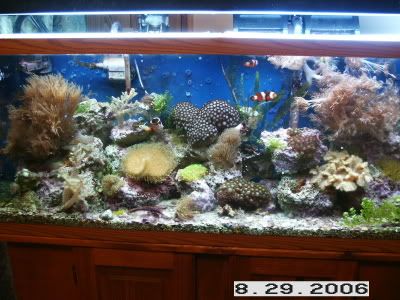njjamie
Member
I have a 55 gallon FOWLR. I have a vermaculated angel, naso tang, 3 damsels (going to store later today top get bigger net so I can get rid of them), 2 skunk shrimp, 1 coral banded shrimp, 12 snails, 12 crabs, 40 lbs of live rock, and 3 feather dusters.......yeah, that is it.
So I have had the tank for around 4 weeks now and I am ready to do my first water change. I just topped off my tank last weekend with 5 gallons of RO water.
I need to know how much I am supposed to be taking out of my tank and replacing?? I am reading a bunch of different answers but maybe someone with experience can tell me about a 55 gallon with the stuff I have in it?? I was thinking about doing a 10% change which is just around 5 gallons, every 2 weeks. What do you guys think about this??
Also, How much of that Alkaline buffer should I be putting in the RO before it goes in the tank?? I am using 5 gallon Sparkletts containers.....you know, the drinking water kinds. The guy at the LFS told me a teaspoon and a half??
Lastly, How often am I supposed to be putting in the Bionic liquid? I have been doing a squirt in the morning and a squirt at night. I premix in a bowl and don't just throw in my tank...........should I not be doing it this frequently??
Still loving this message board,
Jamie
So I have had the tank for around 4 weeks now and I am ready to do my first water change. I just topped off my tank last weekend with 5 gallons of RO water.
I need to know how much I am supposed to be taking out of my tank and replacing?? I am reading a bunch of different answers but maybe someone with experience can tell me about a 55 gallon with the stuff I have in it?? I was thinking about doing a 10% change which is just around 5 gallons, every 2 weeks. What do you guys think about this??
Also, How much of that Alkaline buffer should I be putting in the RO before it goes in the tank?? I am using 5 gallon Sparkletts containers.....you know, the drinking water kinds. The guy at the LFS told me a teaspoon and a half??
Lastly, How often am I supposed to be putting in the Bionic liquid? I have been doing a squirt in the morning and a squirt at night. I premix in a bowl and don't just throw in my tank...........should I not be doing it this frequently??
Still loving this message board,
Jamie

